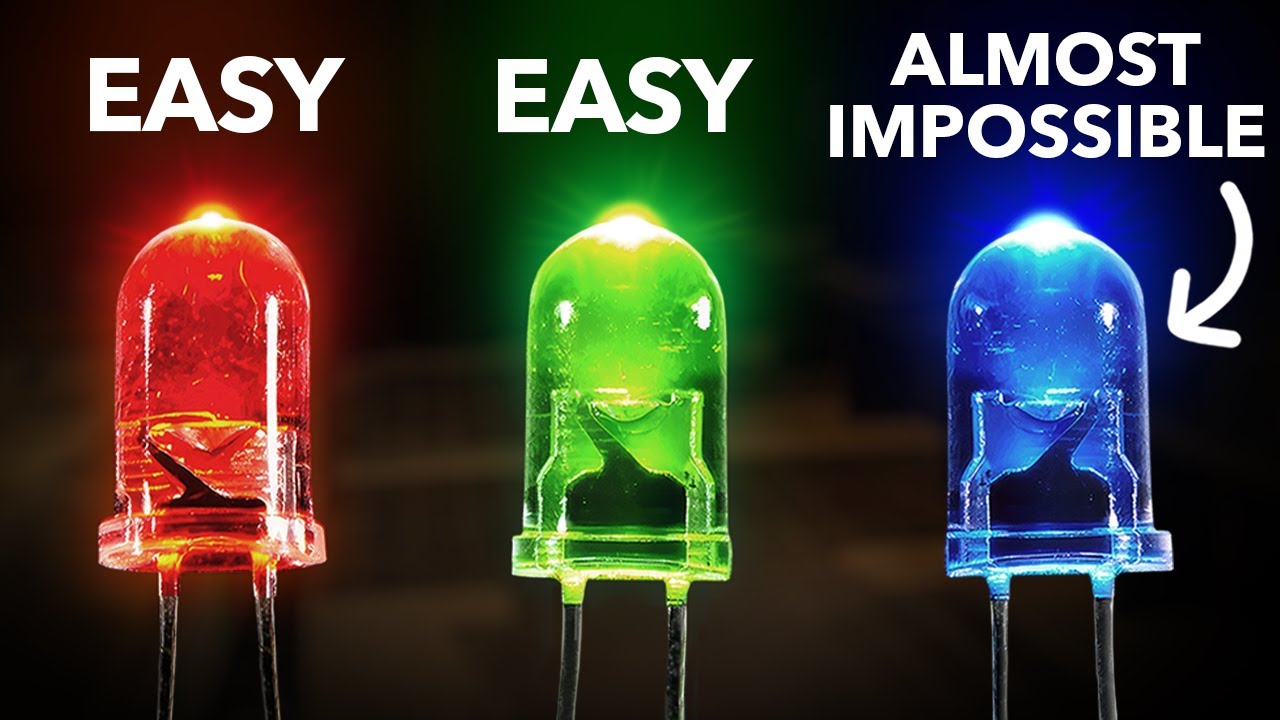- cross-posted to:
- science@lemmy.world
- videos@lemmy.world
- cross-posted to:
- science@lemmy.world
- videos@lemmy.world
The blue LED was supposed to be impossible—until a young engineer proposed a moonshot idea.
That was an excellent watch, thanks for sharing.
YouTube is horrendous for ads though.
Revanced
I aint downloading a two year old microg gmscore apk 💀
You thinking of Vanced? Revanced is updated pretty regularly
No when I patch youtube, it wants me to download this 2 year old gmscore build:
Ah gotcha
Here is an Odysee Link for those that don’t want to give youtube support.
Just a PSA for those who don’t know… no shade against Odysee… I’ve just encountered folks here who don’t know this:
Veritassium and many others on YouTube make their living by the advertising shown on YT. If you’re a premium member, even more money goes to the creator when you watch their content. It’s this very money that allows independent creators to create more / better content!
So they get more from the subscription fee without ads than they from the ad revenue? Many also have their own sponsors, right?
Yes to both!
If they weren’t comfortable with not getting YT ad revenue, they wouldn’t be uploading their content to alternative sites.
Relying on YT as the gatekeeper to your entire livelihood also has a cost. It’s not trivial to calculate but I imagine it’s greater than the loss of AdSense money. There’s a reason many people who rely on video content creation to survive hedge through the likes of Nebula, Floatplane or, indeed, Odyssey.
I wish he posted his stuff on Nebula as well. His stuff totally fits the vibe of the platform, and would potentially make him even more money.
This video is recommended by Tournesol:
[33🌻] Veritasium: Why It Was Almost Impossible to Make the Blue LED#Tournesol is an open-source web tool by a non profit organization, evaluating the overall quality of the information in videos from community made comparisons, to fight against misinformation and dangerous content.
I love Veritasium’s deep dives into the scientists behind various inventions. We really ought to celebrate more people like Nakamura.
My favorite thing about widely-available blue LEDs was the effect on TV scifi.
Watch the Star Trek shows made in the 1980s and 1990s and the tricorders, alien gadgets, and other props were always twinkling with red, yellow, and green LEDs to look futuristic. A generation later and every single hand prop on 2000s Doctor Who, Torchwood, etc. glowed and twinkled blue because the LEDs had just become cheap enough for prop makers, but weren’t yet widespread enough in day-to-day life so that the viewers were seeing something strange and unusual.
Now every color of LED imaginable is just common and whatever, but for a good stretch of time glowy blue became the standard “scifi” color just because that particular tech happened to turn up at that particular time.
Purple still seems to be a tough one for most rgb devices I’ve used lol
They’re still rgb plus maybe yw using colour mixing, so depending on the quality, tuning, physics and our perceptionof light, not all colours are as nice or bright.
Yeah. I just think being RgB it would be good at purple 😂 One of those situations where the name was probably not created based on logic lol
It’s called RGB because there’s a red, green, and blue diode. Not sure how that’s not a logical name.
Oh I was making a joke cause it sucks at purple. Which is red and blue combined generally. But that’s not really how the RGB color cycle works as far as I understand in some extremely cursory Wikipedia reading lol
IIRC, it has something to do with the fact that purple sort of doesn’t actually exist. As I understand, purple is basically your brain going “idk wtf it is but it’s not green”
lol my favorite color would be a weird one. 😂
I’m not sure that LEDs were the thing that kicked off the trend. They made it easier to implement, but even in the 80s and 90s, you had things like Tron that might have kicked off the futuristic look with neon lines/tubes.
9’s sonic screwdriver
The first blue LED I ever saw was on the dashboard of my mom’s VW Golf. I always wanted one like that, but now they’re everywhere!

Before there were blue LED, the indicator light for full beam was a blue tinted incandescent bulb. My parents had a Volkswagen Passat from the 1980s (?) where the usually blue indicator light for full beam was a green LED, since blue ones were not invented back then.
Goodbye night vision
Agreed, though the original wasn’t as bright as the one in the pic. It was a frosted LED and was relatively dim.
I like my car dashboard like I like my 1952 F-86 Saber night variant gauges… Orange
Excellent counter example to anyone claiming that we need patent and copyright to innovate.
This man made nothing on his invention and was not motivated by money but fame.
There are endless of examples of how those who do things for money hold back the creativity that leads to innovation. This is one of them. It almost didn’t happen because his pursuit was not seen as profitable.
This man made nothing on his invention and was not motivated by money but fame.
And then he sued the company for $20 million because the CEO didn’t want to respect his efforts and stiffed him.
And the amount he actually won only covered the legal fees, so he made nothing.
And if he had been granted a patent for his invention, he would have been fairly compensated for his work by being able to license production to companies that had the means to make them at scale. OP seems to think this scenario is an example of how patents should be abolished, but it’s a perfect example of why we have them in the first place. And that reason is so that rich people don’t fuck over comparatively poor inventors.
Your cognitive dissonance is why we cannot improve this system. Patents cannot both be responsible for his lack of profit from his invention and how he would have been fairly compensated.
Parents do exists and we was not fairly compensated, therefore patent do not solve their intended problem.
We live in this reality. Not whatever rose colored version you think could exist if we just get the correct tweaks in place.
At some point we need to stop trying to adapt the concepts people came up with hundreds of years ago. Created in a world that no longer resembles our own.
Consider how contentious the issue was that they redefined to included it in the constitution. The consider what other contentious issues were also included in that same document, i.e. the three fifths compromise.
Parents do exists
Phew, was scared there for a second.
Sure, but the company fronted the millions of dollars required to develop the technology. The investment needs to come from somewhere.
That doesn’t have to be a private company, though. We need public funding that retains the patent rights, if not just to make the invention free from licensing costs to manufacture.
The insane thing about our current system is that we do have public funding, but private companies wind up with the patent anyway
The company didn’t invent it. A person did. The company almost stopped it from being invented. They didn’t spend millions inventing this. A person spent tens of thousands of hours inventing it.
That the funding is only available from a company is a result of the patent system. It does not spur development, it perverts it. Any ideas to the contrary are propaganda.
People have been inventing shit longer than corporations have existed. People have been inventing things without any guarantee on return on investment for most of human history.
Capitalism is bullshit and the capitalization of ideas harms humanity.
Maybe they didn’t invent it. But he wouldn’t and couln’t have invented it without them.
Someone would have invented it eventually though.
Correct. With or with patents and with or without copyright, it eventually would have been invented.
Edit: Curious if you watched the full video. It clearly indicates that all corporate efforts were heading in an opposite direction and that the path this inventor took was considered to be not profitable and not worth the investment by everyone else working on this. The company he worked for wanted to shut down his research and focus on following the herd. No one else was close to his level of progress and capitalist interests almost scuttled this invention.
Yes, I watched the video. Inventing stuff is obviously very expensive and I doubt anyone could have done it without being financed in some way.
Why are you so sure that the eventually hypothetical inventor wouldn’t have patented it? Inventing is expensive and one would presumably want to make the millions spent on the project back and isn’t your time worth anything?
I am happy that the invention wasn’t delayed considering how much it has changed the world.
I mean, the video even showed that there WERE notable people other than him travelling down the same path, his first few leaps were copied off them, he just figured out the last few himself
Yeah it’s pretty bad and nobody talks about it. Nobody researches the effects of patents on our global civilization. I suspect the practical role of patents is to actually retard innovation - something gets improved or invented or most of the time just engineered to work better and monopolization or just paperwork makes it too expensive for wide spread adoption. This in turn helps prevents disruptive technology from making large scale investments obsolete - instead of having to adopt and improve your factories you can continue as before because any innovation will be slow and also priced to be around as expensive as existing solutions. Or the patent can just be bought. And even if an inventor has noble intentions, starting manufacturing yourself is a totally different skill set so like most startups often fails and then the patent gets sold off. Innovation becomes a commodity.
This is my logical conclusion but it’s speculative. I suspect researching negative effects of patents is a somewhat “taboo” topic for scientists to research.
In regards to climate change this becomes… genocidal. We have hundreds of thousands of industrial processes that rely on fossil fuels or certain levels of energy. With all the before mentioned effects this basically made a timely response to climate change impossible. Every little improvement to existing processes is patented and maximized for profit. Basically we never had a chance.
Making blue LEDs is easy. Just make a red one, then move towards it really fast.
Doppler effect?
Yeah but it only works if the source is moving towards the observer
https://en.m.wikipedia.org/wiki/Redshift#Blueshift
Essentially yes
Haven’t watch the video yet, but I remember how impressed my step dad was with the blue LED when we got our PlayStation 2. I was like, yeah great whatever let’s play games, at the time.
The blue led was released in 1993. I remember reading an article in Wired magazine (back when magazines were published on paper) about the invention. Gladly, the article is still available online: https://www.wired.com/1995/03/blue-laser/
I talked with some friends about the “true boo-roo” led, and the phrase stuck with us (that’s why I still remember the article). At the time (almost 30 years ago) we had no idea how important the invention was, even when we realized that it allowed for rgb led light.
But we had no idea leds would be miniaturized to be used in screens and be as ubiquitous as they are today. Living through all this technology evolution has been quite the ride.
Wow, thank you for sharing that.
That was a great read, thanks. It made me realise I don’t even remember the last time I changed a light bulb!
I wish I could say the same. I have had one of two that had circuits that burned out. One was cheap and not surprising. The other was a Hue. Speaking of Hues, mine all seemed to stop working with Google Home and one even decided it would permanently be disco time and continually flashes. Zigbee compatible bulbs only from now on for me.
The leds can work for like 20 years. On the other hand the rest of the components are not necessarily going to last that long unfortunately.
Aren’t all Hue bulbs Zigbee? They have some WiFi or bluetooth models now I believe but afaik all of them support Zigbee with a bridge.
I’ve changed my fair share of LED bulbs. Nowhere near the frequency of incandescent though.
I remember reading about this stuff since the eighties and people had a pretty clear idea of the implications.
Well now the digital screen is everywhere, it bends, and some people strap it to their eyes. It’s crazy how far it’s come
Capitalism is just sad
This was an yet another glorious episode from veritasium.
I hope we get well past UVC LEDs. (i.e., shorter wavelengths) UV LEDs are already available. Unfortunately, this progress will stop before X-ray light. With +1 KeV energy, you pretty much must blast off the electrons from the atoms to emit X-rays, which an x-ray tube already does. Or by peeling off a piece of scotch tape.
Maybe making X-ray emitters cheap enough to put in a flashlight isn’t the best idea anyway.
How about cheap enough to put in a fleshlight?
If you have a bone in your penis, you may not be fully human.
Otherwise, don’t x-ray your penis.
X-rays use invisible electromagnetic energy beams to produce images of internal tissues, bones, and organs on film or digital media.
Good advice, but I put a Kleenex in my urethra for safekeeping and I’d love to track it down to get it out again.
Next time you have to fart just squeeze your butt cheeks together real hard. It’ll pop right out.
The fart?
You tell me. Your user name suggests some expertise.
Amateur. It’s in the scrotum along with all the pee.
Maybe not in a flashlight, but the scientific industry would be very pleased with them. Sterilize water and all surfaces in a second? Flash with 200nm light.
What’s wrong with the current UV tubes? Sure, the smaller ones take about 5-10 W to get the job done, so maybe an LED version would be more efficient. If you’re using UV to keep a massive pool clean, then you’re obviously going to be need more of those bulbs, and they can add up to hundreds of watts quite easily. Is that really a big problem though? Having a pool isn’t cheap, so electricity spent on UV probably isn’t going to be your main concern. Making it cheaper is always welcome, but are UV tubes really that big of a problem?
I mean they aren’t instant and have to be within a fairly short distance of the thing you want to sterilize in order to work because they are absorbed by the air. Something like a pool would be practically impossible as water also absorbs UV and a pool is too big to penetrate all the way through just from the sides or bottom. It only works for drinking water because you pass said water through a tube that must be fairly narrow.
Oh yeah and an X-ray could sterilize all the way through an object, not just the surface. Very useful for making things like microwave meals.
Handheld battery powered X-ray devices exist and are widely available. I used to work with those. In Germany you need a permit to operate them. https://www.thermofisher.com/order/catalog/product/de/en/XL2
/c/flashlight sends its regards
D4V2 x-ray edition when?
Sorry sir I have no idea what you are talking about
-
Light = energy, shorter wavelengths= higher energy. Blue light has a shorter wavelength than red light. UV has even more energy. X-Rays have a lot more energy. For reference in the visible spectrum were talking about maybe 1-4 eV (this may be wrong, I’m too drunk to look it up rn).
-
If we want to produce light, the aim is to find an energy gap that has the exact energy gap that corresponds to the wavelength we’re interested in. Typically this corresponds to an electronic transition, i.e. an electron “jumps” into a higher orbital, on its way down it will emit the energy difference as light.
2.1 X-Rays rn are produced by accelerating electrons onto a metal plate with high voltage. The impact of the electron “rips” out an electron in the close vicinity of the nucleus. Another electron will take the place of that electron, the energy gap associated with that process is large, which is why it produces X-Rays.
-
If we want to produce LEDs that emit in the far UV range we have to find large energy gaps in materials which is difficult. We still have to have a way to get the electron across the energy gap using electricity.
-
X-Ray LEDs are probably not realistic, as the energy of x-rays is so large that we have to rip out electrons from the close vicinity of the nucleus… which is already what we’re doing with X-ray tubes.
-
Get past uvc for what purpose?
I imagine that lithography for integrated circuits would be an application, assuming you could make an appropriate photo-resist. The shorter the wavelength, the smaller the possible feature size. Current lithography relies on constructive and destructive interference between wavelengths to create super small features.
As far as “light” it’s already capped out, then. Going shorter there’s only x-ray and then Gamma ray. Gamma ray lithography sounds bad-ass and dangerous.
Gamma rays have so much energy that they are basically emitted only by nuclear processes, as far as I know.
More efficient compact X-ray generators would be pretty huge for science work. We run the diffractometer in my lab at 2 kW and it still takes hours to get a good quality scan
Awesome video. I had no idea about this story.
Here is an alternative Piped link(s):
https://piped.video/AF8d72mA41M
Piped is a privacy-respecting open-source alternative frontend to YouTube.
I’m open-source; check me out at GitHub.
Here’s an Odyssey link too:
https://odysee.com/@veritasium:f/why-it-was-almost-impossible-to-make-the:9
Here’s the lbry link to that Odysee link:
I took a blue sharpie on my white LED - voilà
Your white led is a blue led with a phosphorescent coating.

Well no, but…yeah sure why not haha
It literally is. They even covered that in the post’s video.
Sorry, I totally misread the comment I replied to, disregard haha






















